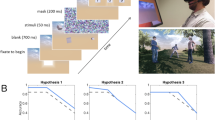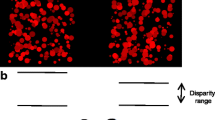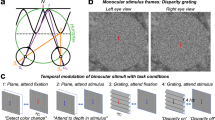Summary
Pigeons possess a binocular visual field and a retinal region of higher cellular density pointing to the center of this overlap. These features and the precision of pecking behavior suggest that in this lateral-eyed bird cues other than monocular ones might participate in depth judgements.
Pigeons were trained with an operant procedure to discriminate between luminous points differing in depth which appeared to the observer as floating in the dark. The accuracy of depth judgements was found to be a function of the ratio between the interstimulus distance and the mean eyes-to-stimulus distance. In a first test (experiment I) no external binocular disparity cues were available, the animal only seeing one luminous point at a time (near or far). In a second test (experiment II) where binocular disparity cues were available, the animal having this time to discriminate a pair of points placed at equal depth from a pair placed at unequal depths, only one pair being visible at a time, depth resolution did not improve. This suggests that, at least within the range of distances explored, the pigeon has no stereoscopic vision. Notwithstanding this, binocular cues do play a role, since when tests were done comparing binocular with monocular viewing (experiment III), monocular depth resolution was significantly worse.
Similar content being viewed by others
References
Binggeli R, Paule W (1969) The pigeon retina: quantitative aspects of the optic nerve and ganglion cell. J Comp Neurol 137:1–18
Bloch S, Martinoya C (1982) Comparing frontal and lateral viewing in the pigeon. I: Tachistoscopic visual acuity as a function of distance. Behav Brain Res 5:231–244
Bloch S, Martinoya C (1983) Specialization of visual functions for different retinal areas in the pigeon. In: Ewert JP, Capranica RR, Ingle D (eds) Advances in vertebrate neuroethology. Plenum, New York, pp 359–368
Blough P (1979) Functional implications of the pigeon's peculiar retinal structure. In: Granda AM, Maxwell JH (eds) Neural mechanisms of behavior in the pigeon. Plenum, New York, pp 71–88
Collett T (1977) Stereopsis in toads. Nature 267:349–351
Delius J, Emmerton J (1979) Visual performance of pigeon. In: Granda AM, Maxwell JH (eds) Neural mechanisms of behavior in the pigeon. Plenum, New York, pp 51–70
Fox R (1981) Stereopsis in animal and human infants: a review of behavioral investigations. In: Aslin RN, Albert JR, Petersen MR (eds) The development of perception: psychobiological perspectives. Academic, New York, pp 335–381
Fox R, Lemmkuhle SW, Bush RC (1977) Stereopsis in the falcon. Science 197:79–81
Frost BJ, Goodale MA, Pettigrew JD (1983) A search for functional binocularity in the pigeon. Proc Soc Neurosci 9:823
Galifret Y (1968) Les diverses aires fonctionnelles de la rétine du pigeon. Z Zellforsch 86:535–545
Goodale M (1983) Visually guided pecking in the pigeon. Brain Behav Evol 2:22–41
Güntürkün O (1985) Lateralization of visually controlled behavior in pigeons. Physiol Behav 34:575–577
Harkness L (1977) Chameleons use accommodation cues to judge distance. Nature 267:346–349
Hodos W, Bonbright JC (1972) The detection of visual intensity differences by pigeons. J Exp Anal Behav 18:471–479
Hodos W, Leibowitz RW, Bonbright JC (1976) Near-field visual acuity of pigeons: effects of head position and stimulus luminance. J Exp Anal Behav 25:129–141
Hughes A (1977) The topography of vision in mammals of contrasting life styles: comparative optics and retinal organization. In: Crescitelli F (ed) The visual system in vertebrates (Handbook of sensory physiology, vol VII/5). Springer, Berlin Heidelberg New York, pp 613–756
Ingle D (1972) Depth vision in monocular frogs. Psychonomic Sci 29:37–38
Jaegger R, Martinoya C, Lemeignan M, Bloch S (1987) Oculomotor behavior during walking in the pigeon. In: Lüer G, Lass U (eds) Fourth European conference on eye movements, vol 1, Proceedings. Hogrefe, Göttingen, pp 112–114
Jahnke HJ (1984) Binocular visual field differences among various breeds of pigeons. Bird Behav 5:96–102
Jones RK, Lee DN (1981) Why two eyes are better than one: the two views of binocular vision. J Exp Psychol 7:30–40
LaMon B, Zeigler HP (1984) Grasping in the pigeon (Columba livia). Stimulus control during conditioned and consumatory responses. Anim Learn Behav 12:223–231
Macko KA, Hodos W (1985) Near point of accommodation in pigeons. Vision Res 25:1529–1530
McFadden SA, Reymond E (1985) A further look at the binocular visual field of the pigeon (Columba livia). Vision Res 25:1741–1746
McFadden SA, Wild JM (1986) Binocular depth perception in the pigeon (Columba livia). J Exp Anal Behav 45:149–160
Martinoya C, Bloch S (1980) Depth perception in the pigeon: looking for the participation of binocular cues. In: Grastyan E, Molnar P (eds) Sensory functions (Advances in physiological sciences, vol 16). Pergamon, Oxford, Akademiai Kiado, Budapest, pp 477–482
Martinoya C, Rey J, Bloch S (1981) Limits of the pigeon's binocular field and direction for best binocular viewing. Vision Res 21:1197–1200
Martinoya C, Le Houezec J, Bloch S (1984a) Pigeon's eyes converge during feeding: evidence for frontal binocular fixation in a lateral-eyed bird. Neurosci Lett 45:335–339
Martinoya C, Palacios A, Bloch S (1984b) Participation of eye convergence and frontal accommodation in programming grain pecking in pigeons. Neurosci Lett 18:223
Matsubayashi A (1937) Forschung über die Tiefenwahrnehmung. II. Acta Soc Ophthal Jpn 41:2055–2074 [quoted by Graham CH (1965) Vision and visual perception. Wiley, New York, p 526]
Mayhew JE, Longuet-Higgins HC (1982) A computational model of binocular depth perception. Nature 297:376–379
Pettigrew JD, Konishi M (1976) Neurons selective for orientation and binocular disparity in the visual wulst of the Barn Owl (Tyto alba). Science 193:675–677
Poggio GF, Poggio T (1984) The analysis of stereopsis. Annu Rev Neurosci 7:379–412
Revzin AM (1969) A specific visual projection area in the hyperstriatum of the pigeon. Brain Res 15:246–259
Rochon-Duvigneaud A (1919) La double fovéa rétinienne des rapaces diurnes. CR Acad Sci (Paris) 169:43–46
Rossel S (1983) Binocular stereopsis in an insect. Nature 302:821–822
Watanabe S, Hodos W, Bessette B (1984) Two eyes are better than one: superior binocular discrimination learning in pigeons. Physiol Behav 32:847–850
Werner C, Himstedt W (1984) Eye accommodation during prey capture behaviour in salamanders (Salamandra salamandra L). Behav Brain Res 12:69–73
Author information
Authors and Affiliations
Rights and permissions
About this article
Cite this article
Martinoya, C., Le Houezec, J. & Bloch, S. Depth resolution in the pigeon. J. Comp. Physiol. 163, 33–42 (1988). https://doi.org/10.1007/BF00611994
Accepted:
Issue Date:
DOI: https://doi.org/10.1007/BF00611994




